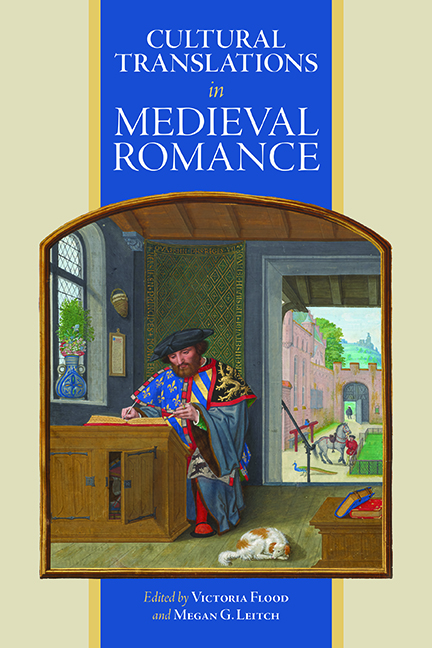Book contents
- Frontmatter
- Contents
- List of Contributors
- List of Abbreviations
- Introduction Insular Romance in Translation: New Approaches
- 1 Romantic Wales: Imagining Wales in Medieval Insular Romance
- 2 ‘Something remains which is not open to my understanding’: Enigmatic Marvels in Welsh Otherworld Narratives and Latin Arthurian Romance
- 3 The Supernatural Company in Cultural Translation: Dafydd ap Gwilym and the Roman de la Rose Tradition
- 4 Women and Werewolves: William of Palerne in Three Cultures
- 5 ‘Better a valiant squire than a cowardly knight’: Gender in Guruns strengleikr (The Lay of Gurun)
- 6 ‘Vinegar upon Nitre’? Walter Map’s Romance of ‘Sadius and Galo’
- 7 The Three Barriers to Closure in Hue de Rotelande’s Ipomedon and the Middle English Translations
- 8 Trojan Trash? The Seege or Batayle of Troye and the Learning of ‘Popular’ Romance
- 9 Poaching Romance: Fan Fiction Theory and Shared Medieval Narratives
- 10 Between Epic and Romance: The Matter of England and the Chansons de Geste
- 11 Geographies of Loss: Cilician Armenia and the Prose Romance of Melusine
- 12 ‘All this will not comfort me’: Romancing the Ballad in The Squire of Low Degree
- 13 Merchants in Shining Armour: Chivalrous Interventions and Social Mobility in Late Middle English Romance
- Index of Manuscripts
- General Index
- Miscellaneous Endmatter
5 - ‘Better a valiant squire than a cowardly knight’: Gender in Guruns strengleikr (The Lay of Gurun)
Published online by Cambridge University Press: 07 October 2022
- Frontmatter
- Contents
- List of Contributors
- List of Abbreviations
- Introduction Insular Romance in Translation: New Approaches
- 1 Romantic Wales: Imagining Wales in Medieval Insular Romance
- 2 ‘Something remains which is not open to my understanding’: Enigmatic Marvels in Welsh Otherworld Narratives and Latin Arthurian Romance
- 3 The Supernatural Company in Cultural Translation: Dafydd ap Gwilym and the Roman de la Rose Tradition
- 4 Women and Werewolves: William of Palerne in Three Cultures
- 5 ‘Better a valiant squire than a cowardly knight’: Gender in Guruns strengleikr (The Lay of Gurun)
- 6 ‘Vinegar upon Nitre’? Walter Map’s Romance of ‘Sadius and Galo’
- 7 The Three Barriers to Closure in Hue de Rotelande’s Ipomedon and the Middle English Translations
- 8 Trojan Trash? The Seege or Batayle of Troye and the Learning of ‘Popular’ Romance
- 9 Poaching Romance: Fan Fiction Theory and Shared Medieval Narratives
- 10 Between Epic and Romance: The Matter of England and the Chansons de Geste
- 11 Geographies of Loss: Cilician Armenia and the Prose Romance of Melusine
- 12 ‘All this will not comfort me’: Romancing the Ballad in The Squire of Low Degree
- 13 Merchants in Shining Armour: Chivalrous Interventions and Social Mobility in Late Middle English Romance
- Index of Manuscripts
- General Index
- Miscellaneous Endmatter
Summary
<E>n bok þessor er hinn virðulege hacon konongr let norróena or volsko male ma hæita lioða bok. þui at af þæim sogum er þæssir bok birtir gærðo skolld i syðra brætlande er liggr i frannz lioðsonga. þa er gærazc i horpum gigiom. Simphanom. Organom. Timpanom. Sallterium. ok corom. ok allzkonar oðrum strænglæikum er menn gera ser ok oðrum til skemtanar þæssa lifs.
(This book, which the esteemed King Hákon had translated into Norse from the French language, may be called ‘Book of Lays’, because from the stories which this book makes known, poets in Brittany – which is in France – composed lais, which are performed on harps, fiddles, hurdy-gurdies, lyres, dulcimers, psalteries, rotes, and other stringed instruments of all kinds which men make to amuse themselves and others in this world).
Although it here names itself ‘Book of Lays’ (‘lioða bok’), the mid-thirteenth-century translation of French lais into Old Norse prose has been known, since the first printed edition in 1850, by a title derived from later in this passage: Strengleikar (the word appears in the dative plural in the above quotation and literally means ‘stringed instruments’, though it corresponds to ‘lay’ in titles of texts). Much of the scholarship on Strengleikar has compared the Norse tales with surviving texts of their French sources. This chapter sets out instead to illuminate the process of cultural transmission by looking at one of four lays in Strengleikar for which no French version survives: the narrative known variously as Gurun, Guruns ljóð, or Guruns strengleikr. Gurun is the eleventh of the twenty-one lays in Strengleikar. It is a short text, just over five pages long in a modern edition.
This chapter begins by examining the relationship of the Norwegian text to insular romance. It then explores gender issues in Gurun from two complementary perspectives. First, Eve Kosofsky Sedgwick's theorisation of the homosocial provides a starting point from which to analyse the relationships between the text's four main characters: the knight Gurun, the woman he falls in love with, her dwarf-guardian, and the harper whom Gurun employs as a go-between. I then show how a single sentence in which the dwarf articulates an ideal of masculinity relates the text's gender ideology to a specifically Norse cultural context.
- Type
- Chapter
- Information
- Cultural Translations in Medieval Romance , pp. 101 - 116Publisher: Boydell & BrewerPrint publication year: 2022

